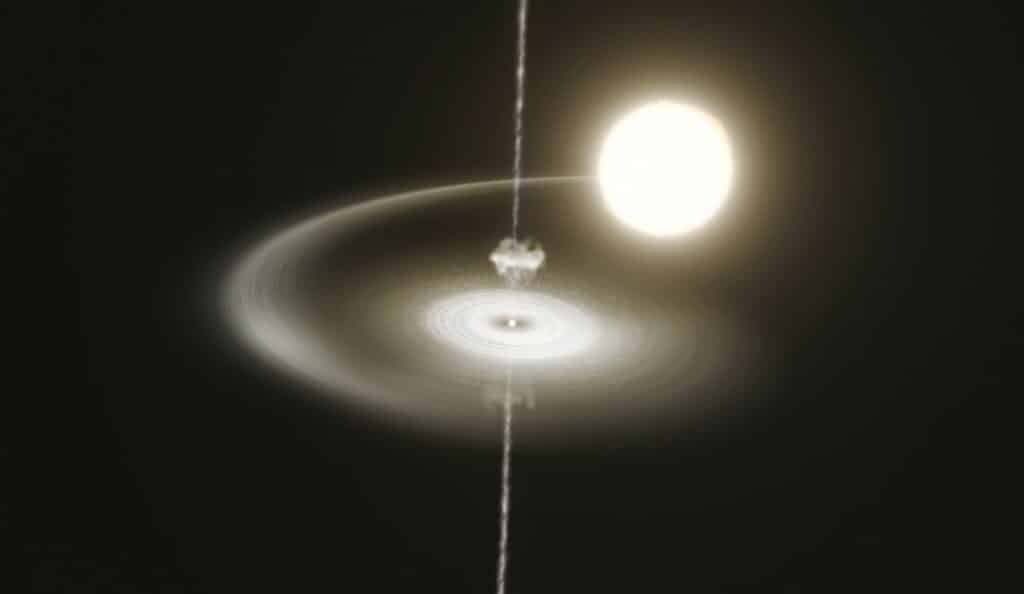In a unique discovery that required the use of 12 different telescopes across Earth and space, astronomers have cracked the code of a pulsar’s strange behavior. Known as a rapidly spinning, magnetic dead star, this pulsar had perplexed scientists due to its ability to switch between two distinct brightness levels almost instantly. Researchers now say the pulsar hurls matter into space like “cosmic cannonballs,” and this activity is behind the abrupt changes in brightness.
A pulsar is essentially the remains of a dead star that didn’t quite turn into a black hole. Imagine a star as dense as our Sun but only a few miles in diameter. This dense object spins extremely fast and emits a beam of radiation into space. Think of it as a cosmic lighthouse, sweeping its beam across the universe. When this beam passes our line of sight, the star appears to pulse or flicker, which is why we call it a “pulsar.”
Meet PSR J1023+0038: The Pulsar with a Cosmic Quirk
The pulsar in question is officially known as PSR J1023+0038 or J1023 for short. Located about 4,500 light-years away, J1023 is unique because it’s not alone; it orbits another star. This second star is a rich source of material for J1023, which pulls in matter that eventually forms a disc around it.
Over the last decade, J1023’s behavior has been erratic. It has two modes: a “high” mode where it shines brightly in X-rays, ultraviolet, and visible light, and a “low” mode where it’s dimmer but emits more radio waves. The puzzling part? It can switch between these modes in mere seconds.
“We have witnessed extraordinary cosmic events where enormous amounts of matter, similar to cosmic cannonballs, are launched into space within a very brief time span of tens of seconds from a small, dense celestial object rotating at incredibly high speeds,” says Maria Cristina Baglio, researcher at New York University Abu Dhabi and lead author of the study, in a statement.
Cracking the Code
The team of astronomers, who published their findings in the journal Astronomy & Astrophysics, conducted an “unprecedented observing campaign” involving various telescopes like ESO’s Very Large Telescope (VLT), New Technology Telescope (NTT), and the Atacama Large Millimeter/submillimeter Array (ALMA).
They found that the weird mode-switching is due to the pulsar throwing out blobs of matter into space. When in “low” mode, the matter flows towards the pulsar but is expelled in a narrow jet. This expelled matter accumulates and heats up due to the pulsar’s wind, causing the system to go into “high” mode, glowing brightly. Eventually, chunks of this hot matter are hurled into space by the pulsar, bringing it back to the ‘low’ mode.
“’We have discovered that the mode switching stems from an intricate interplay between the pulsar wind, a flow of high-energy particles blowing away from the pulsar, and matter flowing towards the pulsar,” explains Francesco Coti Zelati, co-lead author of the paper.
The Road Ahead
This new understanding of J1023 opens doors to further research. Scientists plan to continue their observations, especially when ESO’s Extremely Large Telescope (ELT) becomes operational. “The ELT will allow us to gain key insights into how the abundance, distribution, dynamics, and energetics of the inflowing matter around the pulsar are affected by the mode switching behavior,” says Sergio Campana, Research Director at the INAF Brera Observatory and coauthor of the study.
So, the next time you look up at the night sky, remember that out there is a cosmic lighthouse playing a complex game of “switcheroo,” and scientists are one step closer to understanding its intricate dance.













